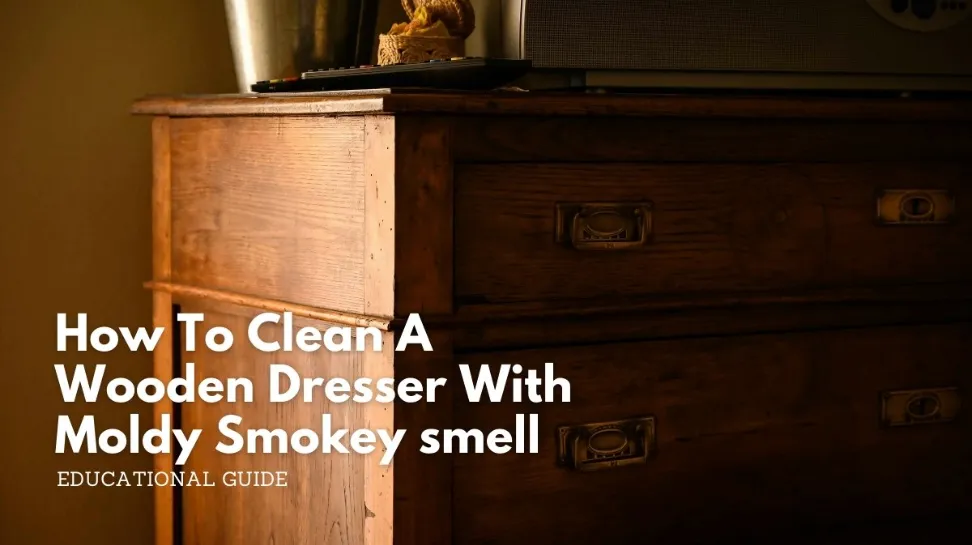How To Clean A Wooden Dresser With Moldy Smokey Smell
How to Clean a wooden dresser with Moldy Smokey smell is a common question especially if you pick it up along sidewalks. A wooden dresser is a valued piece of furniture, but it can develop stubborn odors like mold and smoke. These smells can seep deep into the wood grain, making them tough to remove. Mold suggests fungal growth, which may lead to discoloration and structural damage if not addressed. Smoke leaves behind a sticky residue that sticks to surfaces and produces a strong scent. Each issue needs its own cleaning methods.
This guide offers a step-by-step approach to clean your dresser, get rid of these smells, and bring it back to a fresh, beautiful state.
Table of Contents
Understanding the Problem: Mold and Smoke on Your Wooden Dresser
Mold thrives in damp, dark, and poorly ventilated areas. Mold spores are everywhere in the air. When they land on wet wood, they grow and feed on the wood and any dirt present. As mold develops, it releases compounds that create a musty smell. It can show up as fuzzy patches or discolored spots and can penetrate deep into the wood, weakening it over time. The key to eliminating mold is to remove its moisture source and physically clear the growth.
Smoke poses a different challenge. When materials burn, they release tiny particles and gases that stick to surfaces. These particles condense into soot, carrying a strong odor that becomes embedded in the wood. Simply airing out the dresser rarely works. The smoke particles must be broken down and neutralised. Understanding the differences between mold and smoke is crucial for choosing the right cleaning methods.
Essential Tools and Materials for Cleaning Your Wooden Dresser
Before you start, gather these items:
- Personal protective equipment: gloves, an N95 respirator mask, and protective eyewear.
- Cleaning tools: soft cloths, sponges, buckets, and a stiff bristle brush for removing loose mold.
- Cleaning agents: mild dish soap, white vinegar, baking soda, denatured alcohol, and a specialized wood cleaner.
- Optional odor absorbers: activated charcoal and coffee grounds.
- For deeper treatment: fine-grit sandpaper and wood sealant or finish.
Having these supplies on hand will help ensure a smooth and safe cleaning process.
Step-by-Step Guide
Preparation and Safety
Move the dresser to a well-ventilated area, preferably outdoors. Wear gloves, an N95 mask, and protective eyewear. Take out all drawers and empty them completely. Check for loose parts or structural weaknesses before starting.
Tackling the Mold on Your Wooden Dresser
Brush off visible mold outdoors with a dry stiff brush. Use a vacuum with a HEPA filter to capture spores. Mix equal parts white vinegar and water, dampen a cloth, and wipe all affected areas.
For stubborn stains, let the solution sit briefly before scrubbing. For unfinished wood with heavy mold, use a diluted bleach solution only after testing it on a small spot. Wipe clean with water, dry thoroughly, and let the dresser fully air dry.
Eliminating the Smoky Smell
Mix equal parts white vinegar and water, wipe all surfaces, and let them air dry. For tougher odors, create a paste of baking soda and water. Apply it to the affected areas, let it sit for several hours, then wipe clean.
Place activated charcoal or coffee grounds inside the drawers for several days to absorb odors.
Whenever possible, air out the dresser in sunlight.
Deep Cleaning and Deodorizing Drawers
Clean the drawers with the same vinegar solution, paying special attention to corners and bottom panels. Use the baking soda paste if necessary. Make sure the drawers are fully dry. To control ongoing odors, line the drawers with cedar sheets or put odor absorbers inside. You might consider sealing the interior with shellac for long-term odor prevention.
Sanding
If odors or stains are deeply embedded, lightly sand with fine-grit sandpaper along the grain. Be careful not to remove too much wood, especially with veneers. Clean away dust thoroughly before refinishing.
Sealing and Finishing
Once clean and dry, apply a finish like clear lacquer, varnish, polyurethane, or natural oil. Shellac works particularly well for sealing odors. Follow product instructions and work in a ventilated area. Allow the finish to cure fully before using the dresser.
Prevention is Key
Maintain humidity levels between 45 and 55 percent to protect wood. Use a dehumidifier in humid climates and avoid placing the dresser directly against walls.
Occasionally air out drawers and use cedar blocks or silica gel inside to absorb moisture. Dust regularly to stop organic buildup. Avoid smoking indoors to prevent future smoke odors.
Related: Read more on this article for tackling mold problems on outdoor wooden furniture with fast, effective solutions.
Frequently Asked Questions
Is mold on wooden furniture dangerous?
Yes. Mold can cause respiratory issues and allergic reactions, especially for sensitive people. It can also harm the furniture structurally and aesthetically. Address it promptly.
Can I use bleach on all types of wood?
No. Bleach should only be used on unfinished solid wood and in a highly diluted form. It can damage finishes and cause discoloration.
How long does it take to remove smoke smell from wood?
It depends on the severity. Light odors may fade in days, but strong, embedded smells can take weeks or months of repeated cleaning and airing. Severe cases might need sanding and sealing.
What if the smell does not go away?
Persistent odors may need sanding or sealing with an odor-blocking primer. Professional restoration services might be necessary for valuable or badly damaged pieces.
Can I paint over moldy wood?
No. Painting over mold traps moisture and allows growth to continue. Clean and dry thoroughly before applying any finish.
By understanding the causes of mold and smoke odors, using the right tools, and following a systematic cleaning process, you can restore your wooden dresser to a fresh and beautiful state while preventing future problems.
This article contains affiliate links #ad

